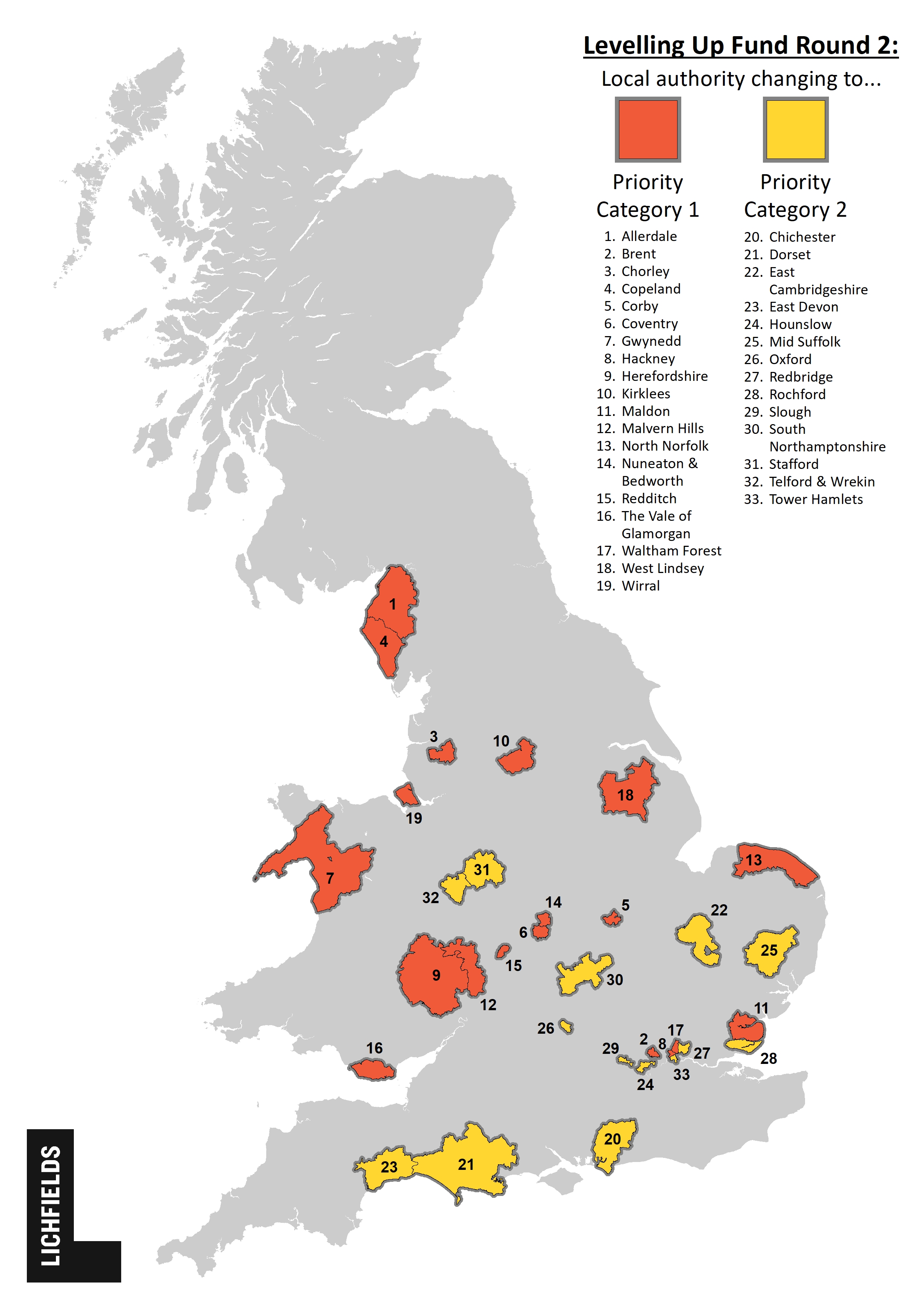Shortly after last week’s Spring Statement (see our summary
blog), the Government launched the second round of the Levelling Up Fund (LUF), with an updated
prospectus inviting eligible applicants to submit bids by Wednesday 6th July.
The second round follows the same criteria and investment themes as applied in the first round, which awarded £1.7 billion of the total £4.8 billion that has been allocated for the LUF. Our earlier
analysis of Round 1 awards revealed that first round funding allocations were weighted towards northern parts of the country and the Midlands, but with some notable exceptions in the form of the North East (which has been awarded a much smaller share than its neighbouring regions) and the South East (which secured almost as many successful first round projects as the North West). There was also a particular focus on town centre regeneration projects, equivalent to 57% of projects and 53% of total investment value awarded.
A significant change in this second round has been the addition of 19 local authorities moving up into Priority Category 1, and 14 local authorities moving to Priority Category 2. These changes are the result of an update to the ‘
Index of Priority Places’, which the government uses as an overall measure of ‘need’ for levelling up, whereby Category 1 has the greatest priority. This reflects that the Index has been updated using the latest available datasets.
The core function of the Index to measure places' need for investment based on the scope of the Fund's investment priorities (unchanged for the second round) and considers the following:
- Need for economic recovery and growth (considering productivity, skills, and unemployment)
- Need for improved transport connectivity (England only)
- Need for regeneration (considering commercial and dwelling vacancy rates) (England and Wales only)
The original Index used the latest year or point-in-time estimates of places' characteristics, which provided a 'snapshot' of their level of need. However, since the original Index was developed more recent data has been published showing the sudden economic impacts of the Covid-19 pandemic in certain areas across the UK.
The potential problem with updating the Index is that the sudden and significant impacts of Covid-19 may have caused temporary fluctuations in the Index's underlying data for some places, and that may not be fully representative of the places' longer-term levels need. However, the Department for Levelling Up, Housing and Communities (DLUCH) has sought to counterbalance this by using two-year averages for all metrics where the updated datasets cover the post-2019 period. Using two-year averages instead of the latest year or point-in-time data provides a less volatile picture of places' level of need while still capturing Covid-19 impacts where they remain meaningful.
As a result of the updates to the Index, the scores for individual places have changed relative to the first round, and some have moved category. It is emphasised within the prospectus that no local authorities have been allowed to move down to a lower category despite this update. Also, the updated Index accounts for local government restructuring in Northamptonshire, resulting in seven district councils merging into two larger unitary authorities (West Northamptonshire and North Northamptonshire). The updated index categorisations and those authorities which have moved categories are shown in Figures 1 and 2.
Figure 1: Levelling Up Fund Priority Index (2022)
Source: Lichfields
Figure 2: Changes to Priority Areas
Source: Lichfields
Of the local authorities that have moved up to Priority Category 1, the majority (14 out of 19) are located in the north and Midlands, two are located in Wales (Gwynedd and Vale of Glamorgan), and three are within London (Hackney, Waltham Forest and Brent). On the other hand, more than half (8 out of 14) local authorities that moved up to Priority Category 2 are located in the south of the country, three of which were London boroughs, including Hounslow, Tower Hamlets and Redbridge.
Taken overall, the Index now allocates 139 local authorities to Priority Category 1, 117 local authorities to Priority Category 2 and the remaining 107 local authorities to Priority Category 3. The results of Round 1 show that these categorisations are important – our analysis indicated that some 60% of successful first round projects were located within Category 1 local authority areas, amounting to £1.2 billion of the total £1.7 billion awarded. However, lower priority areas still received over £423 million.
With the Spring Statement not allocating any further funding towards levelling up, and the arrangements for the UK Shared Prosperity Fund still to be confirmed (Government has indicated further details will be published this spring), LUF Round 2 represents a significant and more immediate opportunity for local authorities to access funding in support of local projects. Some £1.7 billion remains available to be allocated.
Lichfields has been working with local authorities and scheme promoters across the country to help develop bid proposals and to prepare the necessary supporting business case and due diligence. To find out how we might be able to support, please do not hesitate to get in touch.





